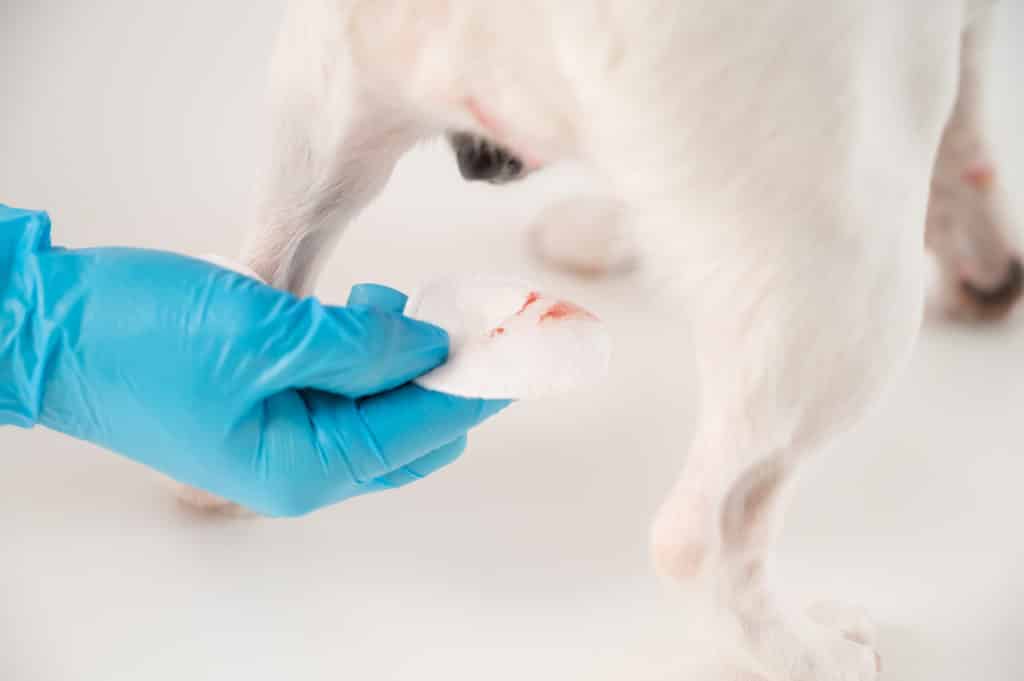Dog Health, Dog Lifestyle, Dog Training
Dog Heat Cycles: All Your Questions Answered
If you have an unspayed female dog, they’ll experience a heat cycle. During this time there will be certain signs to look out for, alongside behavioural changes as she becomes more receptive to mating. In this guide, we’ve got all the answers to your questions on dog heat cycles including how long they bleed and how often it occurs, as well as our top care tips for making her more comfortable.
Signs of a dog in heat
If you think your female dog is in heat, you may spot some of the following signs:
- More frequent urination or marking behaviours
- Swelling and redness to her vulva
- Bleeding or blood-tinted discharge
Common behaviours of a female dog in heat
Alongside the physical signs listed above, there will be some behavioural changes too:
- More friendliness to you and other dogs
- She may actively seek out male dogs
- Mounting or humping behaviours may be seen – cushions and legs are quite common targets
- She might turn her tail to the side
- Fidgety or nervous behaviours can be common
The dog heat cycle shouldn’t hurt your dog, so if she seems uncomfortable or in pain, contact your vet as soon as possible.
When does the dog heat cycle begin?
When the dog heat cycle begins will depend on the size of your dog. Smaller dogs tend to experience their first heat earlier at around four months old, whereas larger dogs may not have their first until they’re between 18 to 24 months old. An average for the first dog heat cycle is around six months of age.
When they first begin it’s normal for them to be irregular and it can take up to two years for them to settle into their normal cycle.
How often is a dog in heat?
As with when they first experience their cycle, how often they come into heat also has a lot to do with their size, as well as their breed and age. In most cases, heat cycles will occur twice a year, around every six months, however smaller dogs can experience three or even four per year, whereas giant breeds may only have one every 12 months.
Heat cycles tend to last around 18 days, around two to three weeks. As your dog gets older, it’s not uncommon for their heat cycle frequencies to slow down, but unlike humans, they’ll be fertile for their entire lives.
How long does a dog bleed in heat?
Your dog will only bleed for around half of their total cycle time, so between 7 – 10 days. How much bleeding you spot will vary from dog to dog with bigger dogs tending to bleed more than smaller breeds, but if you have a dog that tends to groom and clean themselves regularly, you might not notice much blood at all.
Stages of the dog heat cycle
There are four key stages to the dog heat cycle:
- Proestrus: this is the start of the heat and this stage will last for between 7 to 10 days. At this point, the vulva may start to swell, bleeding begins and male dogs will start to become attracted to her, but she won’t be ready to mate yet and will probably see them off.
- Estrus: estrus is the mating period and will last between 5 to 10 days. Bleeding may either reduce or completely stop.
- Diestrus: at this stage, your dog will either be pregnant if she’s mated or may be experiencing a period of rest. Diestrus will last between 10 to 140 days.
- Anestrus: this is the downtime before the next heat cycle begins, it will likely last for around six months.
How can I stop my dog from going into heat?
The only way to stop your dog’s heat cycles is to get them spayed. This is highly recommended as not only does it prevent unwanted pregnancies and puppies, but it will also reduce the risk of mammary cancer, eliminate uterine infections and ultimately, could lengthen their life.
In some cases, your vet may want to wait and allow your dog to have a heat cycle before spaying, particularly if they’re a large breed. Most vets will also recommend waiting for a certain period after a heat cycle before carrying out the procedure too. Your vet will be able to recommend when’s the best time to spay your dog.
Care tips for female dogs in heat
If your dog’s in heat, it’s important to remember that she’ll be feeling extra hormonal and some extra TLC will do her a lot of good. Try and keep her entertained and distracted to relieve some of her anxiety and discomfort by making time for extra play, walks and fuss.
If you’re worried about her dripping blood around your home, you can try limiting her to a kitchen or somewhere with easy to clean floors. Alternatively, you can try doggie diapers, but these may not be suitable for dogs that like to clean themselves often as not being able to access the area may make them distressed.
You should also keep her away from non-neutered male dogs, which includes inside your house too! Even if they’re related, dogs aren’t picky and they will try to breed. It’s also a good idea to keep her on a lead for walks to prevent her from running off to seek male dogs.
Now you know all about heat cycles in dogs! Looking for more information on caring for your dog? Find out why your dog might be panting, next.


